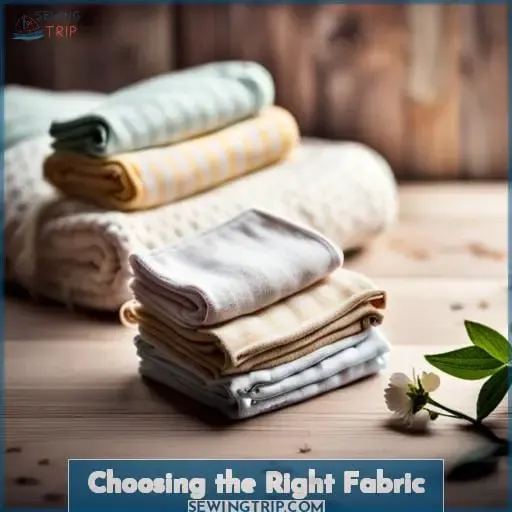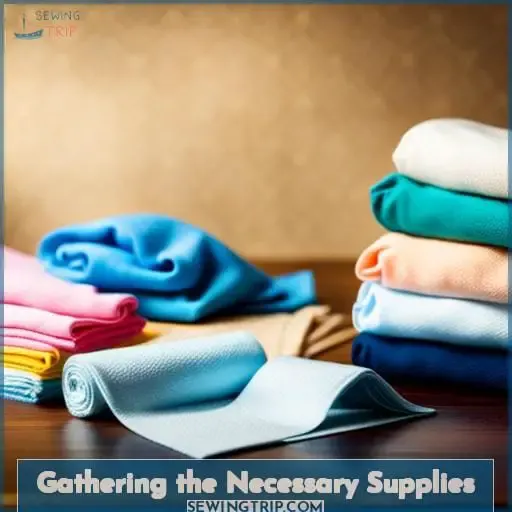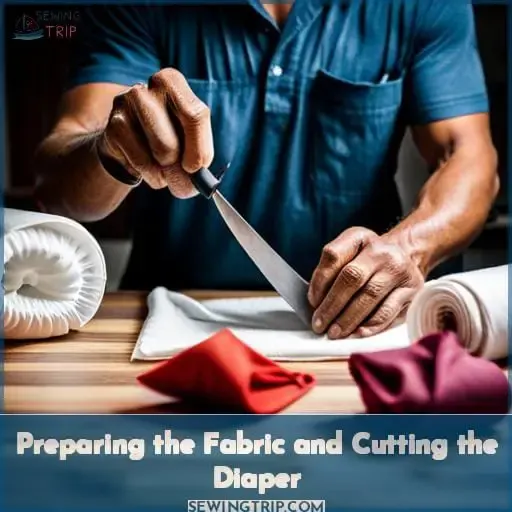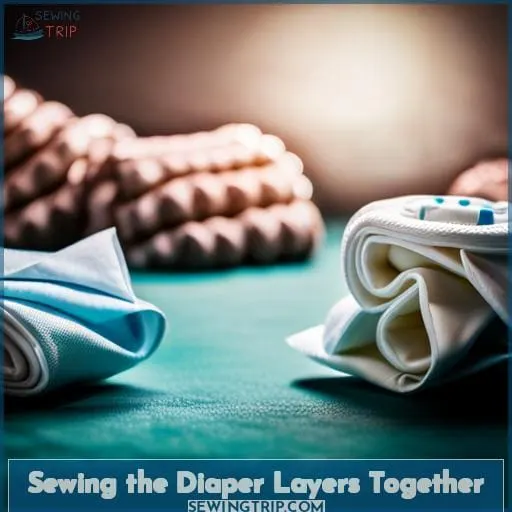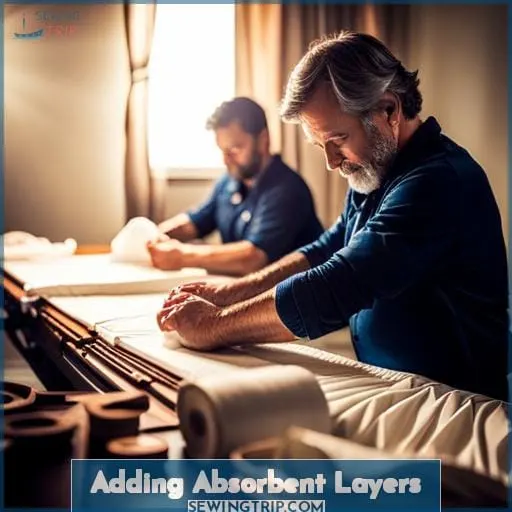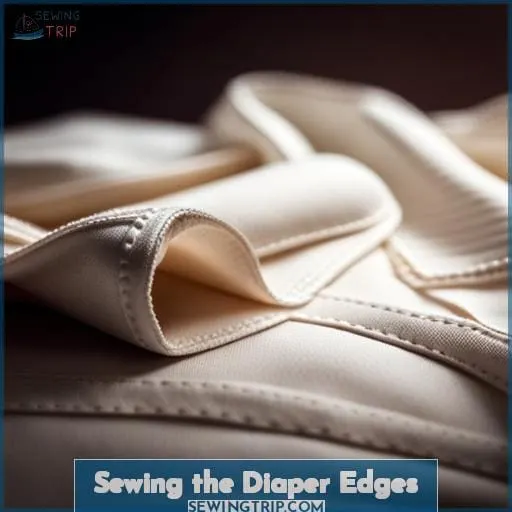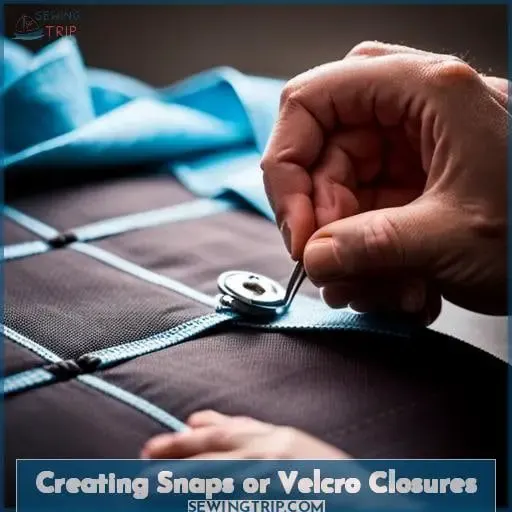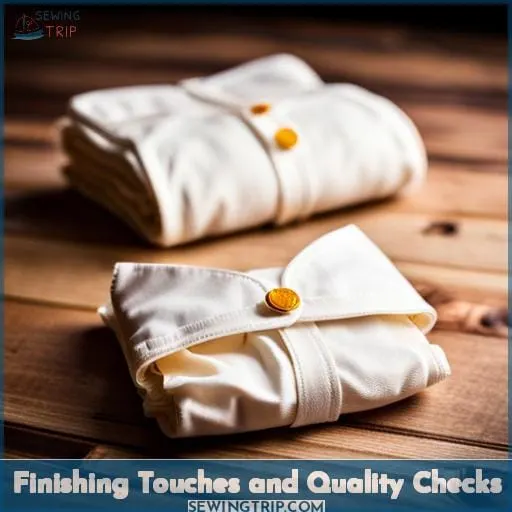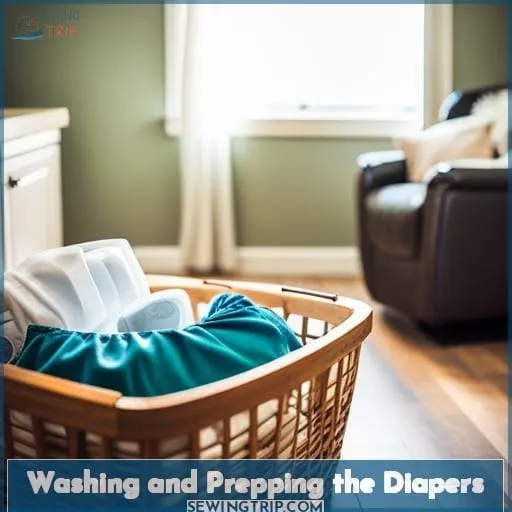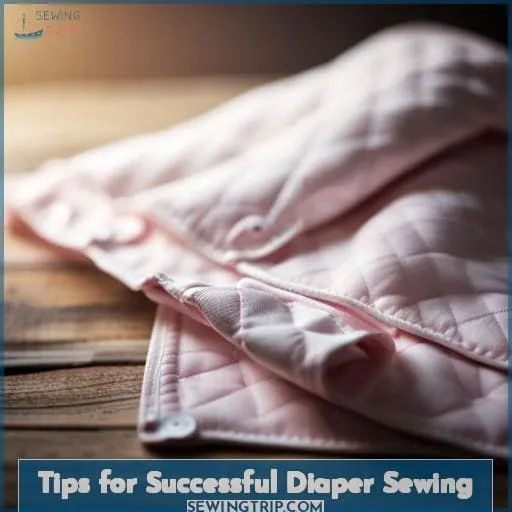This site is supported by our readers. We may earn a commission, at no cost to you, if you purchase through links.
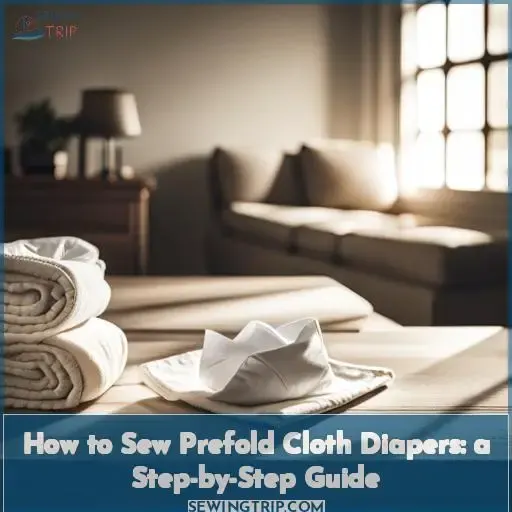 Get ready to become a cloth diapering pro! In this step-by-step guide, you’ll learn how to sew your own prefold cloth diapers. These economical and eco-friendly diapers are perfect for parents on a budget who want to try out the world of reusable diapers.
Get ready to become a cloth diapering pro! In this step-by-step guide, you’ll learn how to sew your own prefold cloth diapers. These economical and eco-friendly diapers are perfect for parents on a budget who want to try out the world of reusable diapers.
From choosing the right fabric to adding absorbent layers and creating closures, we’ve got you covered.
Table Of Contents
- Key Takeaways
- Choosing the Right Fabric
- Gathering the Necessary Supplies
- Preparing the Fabric and Cutting the Diaper
- Sewing the Diaper Layers Together
- Adding Absorbent Layers
- Sewing the Diaper Edges
- Creating Snaps or Velcro Closures
- Finishing Touches and Quality Checks
- Washing and Prepping the Diapers
- Tips for Successful Diaper Sewing
- Frequently Asked Questions (FAQs)
- Conclusion
Key Takeaways
- Flannel and microfiber towels are popular fabric options for prefold cloth diapers.
- Consider repurposing old sheets or exploring sustainable fabric options for cost-effectiveness and eco-friendliness.
- Gather essential sewing supplies beforehand to ensure a successful DIY project.
- Customization options include adding layers like doublers or incorporating alternative fabrics like bamboo or hemp fleece for increased absorbency.
Choosing the Right Fabric
When it comes to choosing the right fabric for your prefold cloth diapers, there are a few options to consider.
- Flannel is a popular choice due to its softness and absorbency.
- You can also repurpose old sheets, which isn’t only cost-effective but also eco-friendly.
- Another option is using microfiber towels as absorbent inserts for your prefolds.
Consider these factors when selecting the fabric for your homemade cloth diapers.
Choosing the right flannel.
To ensure the best quality and absorbency for your prefold cloth diapers, it’s important to carefully choose the right flannel fabric.
When selecting flannel, consider different varieties that offer varying levels of softness and thickness.
Look for sustainable material choices such as organic cotton or bamboo flannel.
You can also explore DIY options by repurposing old flannel sheets or upcycling other fabrics into diaper inserts.
Consider absorbency considerations when choosing a suitable fabric for your prefolds to keep your baby dry and comfortable throughout the day.
Repurposing old sheets.
First, repurpose old sheets by cutting them into the desired size for your prefold cloth diapers.
- Transforming old sheets into eco-friendly options
- DIY sustainability through fabric repurposing
- Creating homemade absorbency with repurposed materials
Using microfiber towels
To use microfiber towels for your prefold cloth diapers, you’ll need to consider their absorbent properties and where to find them.
Microfiber towels are a popular choice due to their high absorbency and quick drying time. They’re eco-friendly options that can be easily sourced from the automotive section of various stores.
These towels come in different thicknesses, so choose one that suits your diapering needs.
Gathering the Necessary Supplies
Now that you have a good understanding of choosing the right fabric for your prefold cloth diapers, it’s time to gather all the necessary supplies. To ensure a successful DIY project, make sure you have everything on hand before diving into sewing.
First and foremost, choose high-quality flannel fabric that’s soft and absorbent. You can either purchase new flannel or repurpose old sheets for an eco-friendly option. If you’re looking to boost absorbency in your diapers, consider using microfiber towels as inserts.
In addition to the fabrics, there are some essential sewing supplies you’ll need such as scissors, pins or clips for holding fabric together during sewing process and a sturdy thread suitable for diaper construction.
By gathering these materials beforehand ,you will be well-prepared when it comes time to sew your prefold diapers.The next step is preparing – cutting out patterns from cut-out shapes made with zig zag stitch.
Preparing the Fabric and Cutting the Diaper
To prepare the fabric and cut the diaper, gather your materials and make sure you have a clean, flat surface to work on.
- Begin by selecting your fabric for the prefold diaper. Flannel is commonly used for its softness and absorbency. Consider repurposing old flannel sheets or purchasing new flannel specifically designed for diapers.
- Once you have chosen your fabric, it’s time to cut the diaper into shape. Start by measuring out large rectangular pieces of fabric according to your desired size (e.g., small, medium or large). For a standard-sized prefold cloth diaper, 18×40 inches is a common measurement.
- Next step: cutting techniques! Using sharp scissors or rotary cutter with a self-healing mat underneath will give you clean edges without fraying.
- If using microfiber towels as an absorbent layer option within your prefolds – this can provide extra absorption capacity – begin by folding them in half lengthwise twice before cutting them down into smaller rectangles that fit inside each folded section of fabric.
- Remember that customization ideas are endless when it comes to sewing prefold cloth diapers! You can experiment with different fabrics like bamboo terry or hemp fleece as well as additional layers such as doublers for increased absorption capability during heavy wetting periods overnight!
In summary:
- Prepare all necessary supplies.
- Choose appropriate material.
- Measure and cut carefully.
- Consider adding optional layers like microfiber towels.
By following these steps in preparing the fabric and cutting the diaper correctly;you’ll be on track towards creating high-quality homemade cloth diapers tailored perfectly for baby’s needs
Sewing the Diaper Layers Together
Next, you’ll sew the layers of the diaper together. This step is crucial for ensuring that your prefold cloth diapers are sturdy and durable.
- Layer stitching: Sew along the center of the diaper layers to secure them in place. This will prevent shifting and ensure even absorption.
- Seam reinforcement: Use a zigzag technique or straight stitch to reinforce the seams, making them stronger and more resistant to wear and tear.
- Secure serging: Finish off by serging or overlocking the edges of your diaper layers. This will give them a clean, professional look while also preventing fraying.
Once you’ve completed these steps, give your prefold cloth diapers a final ironing for a polished finish before using them on your little one.
Adding Absorbent Layers
After sewing the layers of the prefold diaper together, it’s time to add the absorbent layers. This step is crucial for ensuring that your cloth diapers are effective in preventing leaks and keeping your baby dry.
There are various absorbent materials and layering techniques you can use to achieve optimal performance.
One popular option is using microfiber towels as inserts. Microfiber has excellent absorption properties, making it ideal for cloth diapers. To create an absorbent panel, cut a piece of microfiber towel to match the length of the folded edge of your prefold diaper.
By carefully following these steps and paying attention to sewing precision, you’ll be able to create high-quality prefold cloth diapers with reliable absorbency capabilities.
Sewing the Diaper Edges
Now it’s time to sew the edges of the diaper, ensuring a secure and neat finish. Here are some key stitching techniques and edge reinforcement methods to achieve professional-looking results:
- Start by reinforcing the edges with a straight stitch or zigzag stitch. This will prevent fraying and ensure durability.
- Consider using a zigzag stitch for added strength, especially if you anticipate frequent use of the diapers.
- To create extra security, reinforce critical areas such as leg openings with multiple rows of stitching.
By following these seam finishing tips, you’ll have prefold cloth diapers that aren’t only functional but also built to last. Remember that proper stitching techniques contribute greatly to overall diaper quality and can make all the difference in terms of longevity.
Creating Snaps or Velcro Closures
To secure the diaper in place, you’ll need to create snaps or Velcro closures.
Closure preferences vary among cloth diapering parents, so it’s essential to understand the fastening options available.
Snaps and Velcro are popular choices for securing prefold diapers.
Snaps offer a durable and adjustable closure option that ensures a snug fit on your baby’s waist.
They come in various colors and sizes, allowing for customization according to personal preference.
On the other hand, Velcro closures provide convenience with their easy-to-use design that allows for quick changes without hassle.
When choosing between snaps vs.Velcro closures, consider factors such as ease of use, longevity of function (snaps tend to last longer), and your personal preference regarding attachment methods.
Step two: Attach Snap or Velcro Closures
Step three: Compare different closure options before making a decision.
Remember that both snap-on buttons and hook-and-loop attachments like velcros have their pros & cons.
Considerations include durability against frequent washes & potential snagging on delicate fabrics.
Cloth diaper covers can also be used over prefolds if desired.
Finishing Touches and Quality Checks
Once you’ve completed sewing the diaper edges, it’s time to add the finishing touches and perform quality checks.
- Quality control: Carefully inspect each stitch and seam for any loose threads or uneven stitching.
- Fit assessment: Check the size and shape of your finished diaper to ensure it matches your desired specifications.
- Absorbency testing: Pour water onto the center pad of the diaper to test its absorbency. Make sure it can hold an adequate amount without leaking.
- Final inspection: Thoroughly examine every aspect of your completed diaper, including closures, seams, and overall appearance.
By following these steps, you’ll have high-quality reusable diapers that meet all necessary standards.
Washing and Prepping the Diapers
After sewing your prefold cloth diapers, it’s important to properly wash and prep them before use. This step ensures washing efficiency, diaper longevity, fabric softness, and optimal absorbency for your little one.
To start the process, prewash the fabric to remove any residual chemicals or dirt. Then proceed with a regular machine wash using mild detergent on a warm water cycle. Avoid using bleach or fabric softeners as they can affect the absorbency of the diapers.
Once washed, tumble dry on low heat or line dry in direct sunlight for natural disinfection and added freshness. It’s recommended to repeat this process 3-4 times before first use to maximize their performance and ensure optimal cleanliness for your baby’s delicate skin while minimizing environmental impact associated with disposable options.
Washing efficiency is key when it comes to reusable diapers; not only does proper cleaning maintain hygiene standards but it also extends diaper longevity ensuring you get value out of every stitch sewn with love into each piece you’ve created yourself at home from scratch!
To begin this crucial phase in caring for these handmade treasures destined exclusively towards newborn-sized cuteness overload moments all day long (and night!), prepare yourself mentally by understanding how different fabrics behave during laundering sessions – keeping mind such factors as fiber type used within construction materials chosen specifically so they remain gentle against sensitive bottoms without compromising durability needed withstand countless changes throughout infancy stages ahead!
Before placing freshly minted prefolds into what could be considered their natural habitat inside washer drum patiently awaiting arrival dirty companionship rest assured knowing there exists no need worry about initial fabric softness.
As new cloth diapering enthusiasts, it’s understandable concerns surrounding absorbency testing – rest easy knowing these diapers are designed perform exceptionally well even without pre-washing.
As you embark on the journey of washing your prefold cloth diapers for the first time, remember that newborn size is delicate and requires gentle care. Start by doing a prewash with warm water to remove any impurities or chemicals from the fabric.
Then proceed to launder them in a regular machine wash cycle using mild detergent suitable for baby items.
Avoid using bleach or fabric softeners as they can affect the absorbency and lifespan of your diapers. Instead, opt for natural alternatives like vinegar during rinse cycles to ensure optimal cleanliness while maintaining their integrity over time.
Once washed, consider tumble drying on low heat or line drying in direct sunlight if weather permits – this not only aids in quick drying but also offers natural disinfection properties while adding a fresh scent reminiscent those days spent outdoors where nature intertwines seamlessly into our daily lives!
Remember: patience pays off when caring reusable creations crafted love dedication towards environment-friendly parenting practices – so take pride each stitch sewn together; revel delight watching perfection unfold before eyes knowing little one shall soon experience ultimate comfort provided through unparalleled craftsmanship invested every single piece comprising personal collection cherished family heirlooms future generations behold awe admiration.
Tips for Successful Diaper Sewing
Now that you have learned how to wash and prep your cloth diapers, it’s time to dive into the tips for successful diaper sewing. These tips will ensure that your homemade prefold cloth diapers turn out beautifully and function effectively for your little one.
Here are some key considerations to keep in mind:
- Fabric Selection: Choose high-quality materials such as unbleached prefold twill or diaper flannel for optimal absorbency and durability.
- Stitching Techniques: Utilize secure stitching techniques like straight stitch or wide zigzag stitch when sewing the layers together.
- Sizing Considerations: Take accurate measurements and consider adjusting sizes based on personal preferences to achieve a custom fit.
- Closure Alternatives: Explore different closure options such as snaps or Velcro closures depending on your preference.
By taking these factors into account during the sewing process, you’ll be well on your way to creating functional, comfortable, and eco-friendly reusable diapers for your little one!
Frequently Asked Questions (FAQs)
Can prefold cloth diapers be used for newborns?
Yes, prefold cloth diapers can be used for newborns.
They’re versatile and customizable to provide a snug fit.
With proper folding techniques, prefolds offer excellent absorbency and leak protection for your little one.
How many layers of fabric should I use for the absorbent layers?
To achieve optimum absorbency in your homemade prefold cloth diapers, it’s recommended to use multiple layers of fabric.
The more layers you add, the better chance you have at soaking up messes like a sponge!
What type of thread is best for sewing prefold diapers?
To ensure durability, use a strong polyester thread when sewing prefold diapers.
This type of thread is resistant to wear and tear, providing secure stitches that will withstand repeated washing and use.
Can I use different fabrics for the outer and inner layers of the diaper?
Yes, you can use different fabrics for the outer and inner layers of your prefold cloth diapers. This allows for customization based on absorbency needs and personal preferences. Experiment with various combinations to find what works best for you and your baby.
How many prefold diapers should I make for a full stash?
To create a full stash of prefold cloth diapers, aim for around 24-36 diapers.
This allows for frequent changes and ample time to wash and dry.
Conclusion
To become a cloth diapering pro, follow this step-by-step guide on how to sew your own prefold cloth diapers.
With the right fabric, supplies, and sewing techniques, you can create economical and eco-friendly diapers for your little one.
Whether you choose flannel, repurposed sheets, or microfiber towels, there are options to suit your preferences and budget.
By adding absorbent layers, sewing the edges, and creating closures, you’ll have high-quality diapers that are both functional and adorable.
So grab your sewing machine and start your DIY cloth diapering journey today!

